 Virtuosity and Performance
Mastery issue, 2003/04
Virtuosity and Performance
Mastery issue, 2003/04
Forms of Virtuosity in Balanchine's Work and their Virtue
Copyright © Renate Bräuninger, 2003
(No part of this text may be reproduced without the written permission of the author.)
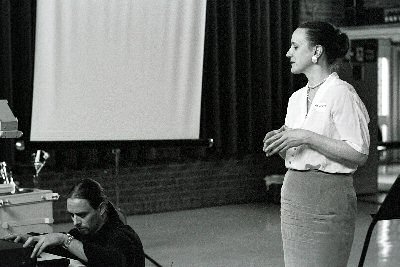
This material was presented live at the Virtuosity and Performance Mastery symposium for postgraduate/research degree students and academic staff over two days by Performing Arts at Middlesex University on 31st May and 1st June 2003.
The question of whether Balanchine wanted highly-trained virtuoso classical dancers that could perform technical tricks which had not been seen yet on stage, can definitely be answered in the affirmative. The question of whether virtuoso dancers were a necessary source of inspiration for Balanchine and whether he relied on them for creating his work, could definitely be answered "No". Balanchine choreographed many of his works before his "ideal" dancer came out of the School of American Ballet, the school he demanded from Lincoln Kirstein when the latter tried to persuade him to come to the United States.
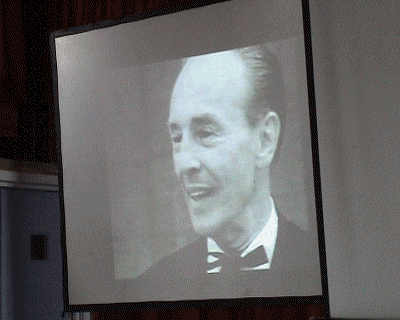 One of his early works is
Serenade, which Balanchine choreographed in 1934 right after his arrival in the
United States. It is conceived as an exercise in rehearsal and performance practice for the
young dancers whom he found when he came to America. The choreography is not very demanding
technically, particularly not for the corps de ballet. Balanchine avoids having the
dancers hold a position for too long. He keeps them constantly moving. There is a lot of
kneeling and standing in positions which are technically easy to execute. By choosing this
choreographic approach Balanchine might have had two goals in mind. One is to cover up the
technical difficulties the dancer had, the other is to help the dancers to become cleaner and
clearer in the execution of ballet steps. Annabelle Lyon remembers, about the rehearsal
process: "I couldn't do fouettés, so he had me run offstage just before that.
Then before the waltz began, he brought me back. I was the one who comes in late, looking for
her place. Now when people try to put meaning to that, it always tickles me".
(1) What I argue this reveals is how
the choreography becomes informed by the given technical abilities of the dancers.
One of his early works is
Serenade, which Balanchine choreographed in 1934 right after his arrival in the
United States. It is conceived as an exercise in rehearsal and performance practice for the
young dancers whom he found when he came to America. The choreography is not very demanding
technically, particularly not for the corps de ballet. Balanchine avoids having the
dancers hold a position for too long. He keeps them constantly moving. There is a lot of
kneeling and standing in positions which are technically easy to execute. By choosing this
choreographic approach Balanchine might have had two goals in mind. One is to cover up the
technical difficulties the dancer had, the other is to help the dancers to become cleaner and
clearer in the execution of ballet steps. Annabelle Lyon remembers, about the rehearsal
process: "I couldn't do fouettés, so he had me run offstage just before that.
Then before the waltz began, he brought me back. I was the one who comes in late, looking for
her place. Now when people try to put meaning to that, it always tickles me".
(1) What I argue this reveals is how
the choreography becomes informed by the given technical abilities of the dancers.
Balanchine would also not have become such a well known choreographer if he waited for his "ideal" dancer to be ready before he started to create some of his major works. Instead he was fully capable of seeing qualities other than technical virtuosity in individual dancers and using them. Excerpts from recordings of the Tchaikovsky Pas de deux (1945) danced by Jacques d' Amboise(2) and Michael Barychnikov (3) show that the work changes according to the technical abilities of the dancer. The choreography is not a stable entity. It opens up to integrate the virtuoso abilities a dancer has to offer. This example shows that Balanchine could adjust a choreography in such a way that the dancer looked good in it. Of course there were limits to what even Balanchine could do for a solo part to adjust to individual dancers and the dancer had to bring certain qualities such as stage presence, musicality and a sense of phrasing. The question that comes up when comparing these two dancers is whether Barychnikov is the better dancer. He is certainly the more virtuoso dancer and he has the more developed and clearer executed ballet technique. This includes stunts such as his jumping up from the supporting leg while executing a pirouette a la seconde. Jacques d' Amboise, "lacking" those technical abilities, delivers his part by projecting the thrill of dancing to the audience. At the same time, and on that basis, Barychnikov's dancing could be described as emotionally detached.
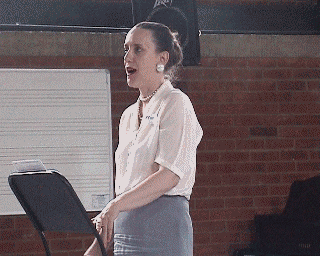 Here we enter the famous debate
which is as old as ballet itself and is "reheated" at various points in history. We
need only think back to the comparison between Marie Sallè and Marie Carmago and Marie
Taglioni and Fanny Elssler. The argument is always concerned with what is to be evaluated
more highly: technical virtuosity of a dancer or her or his expressiveness, acting talent or
stage presence?(4) Where has the fine
line to be drawn then between virtuosity, technical perfection that intrigues us and gives us
pleasure while we are watching, and mechanical execution of technique that does not excite
us? How does the perfect execution of technique distinguish itself from the display of
mastery of one's art? Obviously to the latter there is an extra factor, which is
difficult to define and to capture in language. We might find it in the way the dancer
organises the energy pattern of his movements and in the way she or he switches between
patterns of tension and release while moving. This creates a particular sense of
phrasing.
Here we enter the famous debate
which is as old as ballet itself and is "reheated" at various points in history. We
need only think back to the comparison between Marie Sallè and Marie Carmago and Marie
Taglioni and Fanny Elssler. The argument is always concerned with what is to be evaluated
more highly: technical virtuosity of a dancer or her or his expressiveness, acting talent or
stage presence?(4) Where has the fine
line to be drawn then between virtuosity, technical perfection that intrigues us and gives us
pleasure while we are watching, and mechanical execution of technique that does not excite
us? How does the perfect execution of technique distinguish itself from the display of
mastery of one's art? Obviously to the latter there is an extra factor, which is
difficult to define and to capture in language. We might find it in the way the dancer
organises the energy pattern of his movements and in the way she or he switches between
patterns of tension and release while moving. This creates a particular sense of
phrasing.
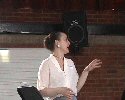 In my own reading, Balanchine
would not insist on a school if he had not been intrigued by the idea of further developing
the ballet technique he learnt at the theatre academy in St. Petersburg, which would then
provide the basis for his choreographic works. The dancers that graduated from the School
of American Ballet and the physical possibilities specific to them, no doubt influenced
the way he conceived work: "sudden[ly] he had dancers at his disposal that could move
faster and jump higher as he ever had imagined."(5) He made use of these dancers and they set the standard
for others. Whether it was the abstractness that characterised modern art - particularly in
America - or Balanchine's problematical relationship with women (to name just two of the
possible explanations) that was responsible for the ideal of the ultra slim dancer cannot be
answered here. Balanchine is rumoured to have asked his dancers to starve and the high leg
extensions he demanded are supposed to have led to a lot of hip replacements. He wanted a
"pinheaded" dancer who was willing to submit to his demands and ruin her health
through starvation and the immense physical demands of the choreography. Feminist scholarship
has explored this side of the Balanchine legacy in depth. Most famously Ann Daly's
article "The Balanchine Woman: Of Hummingbirds and Channel Swimmers", published in
1987, argued that Balanchine's adoration of women, his frequently quoted: "dance is
woman", is not so much an appreciation of woman, but rather his putting woman into place
and controlling her.(6)
In my own reading, Balanchine
would not insist on a school if he had not been intrigued by the idea of further developing
the ballet technique he learnt at the theatre academy in St. Petersburg, which would then
provide the basis for his choreographic works. The dancers that graduated from the School
of American Ballet and the physical possibilities specific to them, no doubt influenced
the way he conceived work: "sudden[ly] he had dancers at his disposal that could move
faster and jump higher as he ever had imagined."(5) He made use of these dancers and they set the standard
for others. Whether it was the abstractness that characterised modern art - particularly in
America - or Balanchine's problematical relationship with women (to name just two of the
possible explanations) that was responsible for the ideal of the ultra slim dancer cannot be
answered here. Balanchine is rumoured to have asked his dancers to starve and the high leg
extensions he demanded are supposed to have led to a lot of hip replacements. He wanted a
"pinheaded" dancer who was willing to submit to his demands and ruin her health
through starvation and the immense physical demands of the choreography. Feminist scholarship
has explored this side of the Balanchine legacy in depth. Most famously Ann Daly's
article "The Balanchine Woman: Of Hummingbirds and Channel Swimmers", published in
1987, argued that Balanchine's adoration of women, his frequently quoted: "dance is
woman", is not so much an appreciation of woman, but rather his putting woman into place
and controlling her.(6)
 However, this is but one side of
the story. On the other side there are numerous accounts from dancers who indicate how
considerate Balanchine was with regard to their health problems and how much he wanted them
to eat properly to keep up their strength. These accounts show us that it is impossible to
create a consistent narrative about the way in which Balanchine treated his dancers. The
diverging narrative might also reflect the differences in personal relationship between him
and his dancers. Balanchine could be rude to his dancers if they did not co-operate in
fulfilling his artistic vision.(7)
Dancers, on the other hand, can be viewed often to have projected their parent-child
relationship onto their relationship with Balanchine, having expectations that he could not
fulfil. Gelsey Kirkland's book Dancing On My Grave provides one example: having
had an old alcoholic father she is desperate to receive Balanchine's attention and wishes
he would explain the meaning of ballet technique itself as well as his ballets to her.
Reportedly Balanchine felt uncomfortable about both demands.(8)
However, this is but one side of
the story. On the other side there are numerous accounts from dancers who indicate how
considerate Balanchine was with regard to their health problems and how much he wanted them
to eat properly to keep up their strength. These accounts show us that it is impossible to
create a consistent narrative about the way in which Balanchine treated his dancers. The
diverging narrative might also reflect the differences in personal relationship between him
and his dancers. Balanchine could be rude to his dancers if they did not co-operate in
fulfilling his artistic vision.(7)
Dancers, on the other hand, can be viewed often to have projected their parent-child
relationship onto their relationship with Balanchine, having expectations that he could not
fulfil. Gelsey Kirkland's book Dancing On My Grave provides one example: having
had an old alcoholic father she is desperate to receive Balanchine's attention and wishes
he would explain the meaning of ballet technique itself as well as his ballets to her.
Reportedly Balanchine felt uncomfortable about both demands.(8)
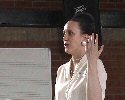 Into this debate comes the
question of whether ballet as an art form is healthy as a practice. It is physically as
demanding as professional athletics while at the same time it follows a particular physical
aesthetic ideal. I do not intend to engage here with the debate led by dance scholars and
educators who have asked for the development of a training mode that is more considerate of
the human body and a moving away from the aesthetic demand of an ultra slim dancer. This
opens up a gap which seems difficult to bridge, between considerations for the dancer's
health and the constantly growing physical possibilities of dancers that allow choreographers
to explore new ranges of movements. As a scholar and former choreographer, I have not solved
that dilemma to my own satisfaction. On the one hand I find many of the practices that go on
behind the scenes, and driven by these demands, rather oppressive - one example is
choreographers who force dancers to rehearse to their physical limits while at the same time
they are required to starve themselves. On the other hand I would also like to see a perfect
performance of a piece. The question which emerges is how the aesthetic particular to 20th
century choreography can be performed without the dancers being pushed to their limits; with
pushing beyond those limits the danger is that virtuosity becomes a destructive force.
Into this debate comes the
question of whether ballet as an art form is healthy as a practice. It is physically as
demanding as professional athletics while at the same time it follows a particular physical
aesthetic ideal. I do not intend to engage here with the debate led by dance scholars and
educators who have asked for the development of a training mode that is more considerate of
the human body and a moving away from the aesthetic demand of an ultra slim dancer. This
opens up a gap which seems difficult to bridge, between considerations for the dancer's
health and the constantly growing physical possibilities of dancers that allow choreographers
to explore new ranges of movements. As a scholar and former choreographer, I have not solved
that dilemma to my own satisfaction. On the one hand I find many of the practices that go on
behind the scenes, and driven by these demands, rather oppressive - one example is
choreographers who force dancers to rehearse to their physical limits while at the same time
they are required to starve themselves. On the other hand I would also like to see a perfect
performance of a piece. The question which emerges is how the aesthetic particular to 20th
century choreography can be performed without the dancers being pushed to their limits; with
pushing beyond those limits the danger is that virtuosity becomes a destructive force.
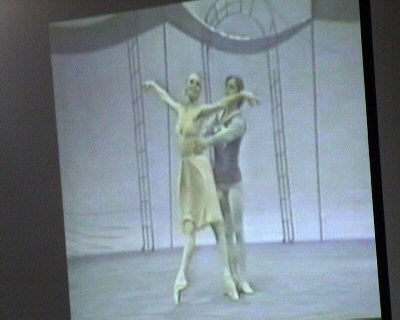 In Balanchine's work a third
notion of virtuosity enters the discourse: this concerns the virtuosity of the work, not only
its execution, but also its artistic form. There is of course a remote chance that dancers
who are technically incapable of executing the choreography perform it a way that it is
hardly recognisable, but even they might not be able to destroy it. Barbara Horgan, his
personal assistant during the last twenty years of his life who is now administrator of the
Balanchine Trust underlines this point: "For the Balanchine repertory to be
available to companies elsewhere is part of our tradition at the New York City Ballet. No
matter how badly they are danced, Balanchine ballets look better on companies than other
ballets, even ballets already in the companies' own repertory."(9) Her observation confirms my point that there is
a balance in the elements inherent in a Balanchine choreography that is independent of the
execution of the work and that remains intact even if the performance is judged critically
to fail. The relationship between the basic units of his choreography like movements cells
developing into larger units, the referencing between the different units which fits into
the architectural plan of the whole, make single ballets virtuosic as such, independently
of the technical abilities of the dancers.
In Balanchine's work a third
notion of virtuosity enters the discourse: this concerns the virtuosity of the work, not only
its execution, but also its artistic form. There is of course a remote chance that dancers
who are technically incapable of executing the choreography perform it a way that it is
hardly recognisable, but even they might not be able to destroy it. Barbara Horgan, his
personal assistant during the last twenty years of his life who is now administrator of the
Balanchine Trust underlines this point: "For the Balanchine repertory to be
available to companies elsewhere is part of our tradition at the New York City Ballet. No
matter how badly they are danced, Balanchine ballets look better on companies than other
ballets, even ballets already in the companies' own repertory."(9) Her observation confirms my point that there is
a balance in the elements inherent in a Balanchine choreography that is independent of the
execution of the work and that remains intact even if the performance is judged critically
to fail. The relationship between the basic units of his choreography like movements cells
developing into larger units, the referencing between the different units which fits into
the architectural plan of the whole, make single ballets virtuosic as such, independently
of the technical abilities of the dancers.
I was aiming in this presentation to show that there are different concepts of virtuosity. One refers to the expressive qualities of the performer as such, one to the perfect execution of technique and the last to the virtuosity of the work itself. The second could be regarded as the least in terms of "virtue". On the other hand, the line between artistry and athleticism cannot really be drawn here and at the same time what might be seen as the self-destructive tendencies of the artist are often encouraged and hinder the dancer's ability to draw the line for herself or himself. I have concluded, from the evidence, that combinations of the three can be found in one or another performance of a work. In some instances we can identify all three, in some instances just one or two.
Endnotes
1. Mason, F. (1991) I Remember Balanchine, New York: Doubleday, p. 142
2. D'Ambroise can be seen dancing this variation in Kinberg, J. (1984) Balanchine I+II, New York: WNET/Thirteen, Societé Radio Canada, BBC
3. Barychnikov can be seen dancing in Kinberg, J. and Brockway, M. (1979) Choreography by Balanchine, Part IV. WNET/Thirteen
4. see for example ballet histories such as Kirstein, L. (1977): Dance. A Short History of Classical Theatrical Dancing. New York: A Dance Horizon Republication.
5. Voice over in Kinberg, J. (1984) Balanchine I+II, New York: WNET/Thirteen, Societé Radio Canada, BBC
6. Daly, A. (1987) The Balanchine Woman. Of Hummingbirds and Channel Swimmers, Drama Review, Connecticut Massachusetts, V. 31, No 1, T113, p8-21
7. See memories of dancers in Mason
8. Kirkland, G. with Lawrence, G. (1986) Dancing On My Grave. New York: Doubleday
9. Mason, F. (1991) I Remember Balanchine, New York: Doubleday, p. 386
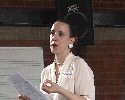 Renate
Bräuninger is a research assistant at Middlesex University and is currently
writing a PhD on the relationship between music and movement, using George Balanchine's
ballets choreographed to Peter Tchaikovsky's music as an example. Her background is in
dance and music. She studied musicology at the Ludwig Maximilias Universität Munich and
the Technische Universität Berlin. A scholarship of the DAAD (Germany Academic Exchange
Service) allowed her to live in New York City where she studied dance theory and criticism
with Marcia Siegel and choreography with Bessie Schönberg.
Renate
Bräuninger is a research assistant at Middlesex University and is currently
writing a PhD on the relationship between music and movement, using George Balanchine's
ballets choreographed to Peter Tchaikovsky's music as an example. Her background is in
dance and music. She studied musicology at the Ludwig Maximilias Universität Munich and
the Technische Universität Berlin. A scholarship of the DAAD (Germany Academic Exchange
Service) allowed her to live in New York City where she studied dance theory and criticism
with Marcia Siegel and choreography with Bessie Schönberg.
Web design, background image and picture of Renate Bräuninger copyright © John Robinson 2003.
Video frames by Hannah Bruce.
Page last updated 30th August 2004.